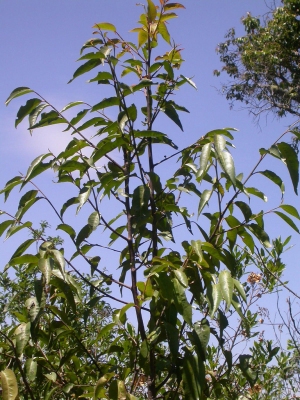Garcinia kingaensis
Engl.
Clusiaceae
Garcinia mlanjiensis Dunkley
Common Name:
General Information
Garcinia kingaensis is an evergreen shrub or tree growing from 3 - 15 metres tall[
308- Title
- Flora Zambesiaca
- Publication
-
- Author
-
- Website
- http://apps.kew.org/efloras/fz/intro.html
- Publisher
-
- Year
- 0
- ISBN
-
- Description
- An excellent online flora of plants from the Zambezi River basin. It lists a number of the plant uses as well as the habitats and botanical descriptions of the plants.
,
398- Title
- Edible Wild Plants of Tanzania
- Publication
-
- Author
- Ruffo, C.K.: Birnie, A. & Tengnas, B.
- Publisher
- Regional Land Management Unit; Nairobi.
- Year
- 2002
- ISBN
- 9966-896-60-0
- Description
- A very well presented, simple guide to growing and utilizing wild food plants in Tanzania, with line drawings of each plant, a description, habitat and range, non-food as well as food uses, plus basic information on growing the plants.
].
The edible fruit is gathered from the wild for local use.
Known Hazards
None known
Botanical References
308- Title
- Flora Zambesiaca
- Publication
-
- Author
-
- Website
- http://apps.kew.org/efloras/fz/intro.html
- Publisher
-
- Year
- 0
- ISBN
-
- Description
- An excellent online flora of plants from the Zambezi River basin. It lists a number of the plant uses as well as the habitats and botanical descriptions of the plants.
Range
East and southern Africa - Tanzania, Zambia, Malawi, Mozambique, S. Africa.
Habitat
Evergreen forest, forest edges; grassland; at elevations from 1,200 - 2,300 metres[
398- Title
- Edible Wild Plants of Tanzania
- Publication
-
- Author
- Ruffo, C.K.: Birnie, A. & Tengnas, B.
- Publisher
- Regional Land Management Unit; Nairobi.
- Year
- 2002
- ISBN
- 9966-896-60-0
- Description
- A very well presented, simple guide to growing and utilizing wild food plants in Tanzania, with line drawings of each plant, a description, habitat and range, non-food as well as food uses, plus basic information on growing the plants.
]. An understorey tree of evergreen rain forest and wooded ravines at elevations from 1,350 - 2,100 metres[
308- Title
- Flora Zambesiaca
- Publication
-
- Author
-
- Website
- http://apps.kew.org/efloras/fz/intro.html
- Publisher
-
- Year
- 0
- ISBN
-
- Description
- An excellent online flora of plants from the Zambezi River basin. It lists a number of the plant uses as well as the habitats and botanical descriptions of the plants.
].
Properties
| Edibility Rating |      |
| Habit | Evergreen Tree |
| Height | 10.00 m |
| Self-fertile | No |
| Cultivation Status | Wild |
Cultivation Details
A dioecious species, both male and female forms usually need to be grown if fruit and seed are required308]. At least some dioecious Garcinia species, however, are able to produce fertile seed even in the absence of fertilization (asexual reproduction). Such seeds would be expected to be genetically identical to the parent[
1798- Title
- Taxonomic Revision of Garcinia Section Garcinia (Clusiaceae)
- Publication
- Phytotaxa 373 (1): 001-052
- Author
- Nazre M., Newman M.F., Pennington R.T. & Middleton D.J.
- Website
- https://doi.org/10.11646/phytotaxa.373.1.1
- Publisher
-
- Year
- 2018
- ISBN
- 1179-3155
- Description
-
]
Edible Uses
Fruit - raw[
398- Title
- Edible Wild Plants of Tanzania
- Publication
-
- Author
- Ruffo, C.K.: Birnie, A. & Tengnas, B.
- Publisher
- Regional Land Management Unit; Nairobi.
- Year
- 2002
- ISBN
- 9966-896-60-0
- Description
- A very well presented, simple guide to growing and utilizing wild food plants in Tanzania, with line drawings of each plant, a description, habitat and range, non-food as well as food uses, plus basic information on growing the plants.
]. The orange-yellow, globose fruit is 10 - 25mm in diameter, containing 1 - 2 seeds[
308- Title
- Flora Zambesiaca
- Publication
-
- Author
-
- Website
- http://apps.kew.org/efloras/fz/intro.html
- Publisher
-
- Year
- 0
- ISBN
-
- Description
- An excellent online flora of plants from the Zambezi River basin. It lists a number of the plant uses as well as the habitats and botanical descriptions of the plants.
].
Medicinal
None known
Other Uses
None known
Propagation
Seed - we have no specific information on this species, but the seed of most members of the genus can be slow to germinate, even if sown fresh, often taking 6 months or more[
K- Title
- Plants for a Future
- Author
- Ken Fern
- Description
- Notes from observations, tasting etc at Plants For A Future and on field trips.
].
If you have any useful information about this plant, please leave a comment. Comments have to be approved before they are shown here.



 Useful Tropical Plants Database 2014 by
Ken Fern,
web interface by
Ajna Fern
with help from
Richard Morris.
Useful Tropical Plants Database 2014 by
Ken Fern,
web interface by
Ajna Fern
with help from
Richard Morris.